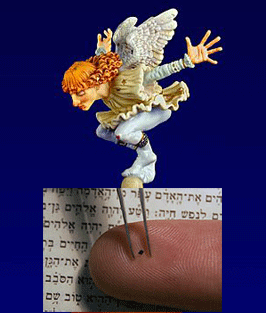
Riddle of the day (stretching back a bit): How many angels can dance on the head of a pin? Before you answer, here is what the theologian St. Aquinas had to say:
Q. 52, a. 3 – “Whether Several Angels Can Be At The Same Time In the Same Place? There are not two angels in the same place. The reason for this is because it is impossible for two complete causes to be immediately the causes of one and the same thing. This is evident in every class of causes. For there is one proximate form of one thing, and there is one proximate mover, although there may be several remote movers. Nor can it be objected that several individuals may row a boat, since no one of them is a perfect mover, because no one man’s strength is sufficient for moving the boat; the fact is rather that all together are as one mover, in so far as their united powers all combine in producing the one movement. Hence, since the angel is said to be in one place by the fact that his power touches the place immediately by way of a perfect container, as was said (Q. 52, a. 1) there can be but one angel in one place.”
So the devout answer would be “one,” assuming it was an angel who knew how to dance.
Next riddle: How many Bible tales can you inscribe on the head of a pin? Here is what the BBC has to say:
Bible put on a pinhead-size chip
BBC News, December 24, 2007Researchers in Israel say they have succeeded in putting a version of the Bible on a chip smaller than a pinhead.
Its 300,000 words in Hebrew were inscribed on a silicon surface at the Haifa Institute of Technology.
Scientists say the aim of the project is to increase young people’s interest in nanoscience and nanotechnology.
The record for the smallest copy is held by a Bible measuring 2.8×3.4x1cm (1.1×1.3×0.4in), weighing 11.75g (0.4 ounces) and containing 1,514 pages.
The 0.5sq-mm (0.01sq-in) nano-Bible was written on a silicon surface covered with a thin layer of gold (20nanometres thick – 0.0002mm).
It was written using a device called Focused Ion Beam (Fib).
“When we send the particle beam toward a point on the surface, the gold atoms bounce off of this point, thus exposing the silicon layer underneath,” Ohad Zohar, one of the project’s managers at Technion, said.
“By sending a particle beam towards various points on the substrate, we can etch any pattern of points, especially one that represents text.”
The next step for Technion researchers is photographing the Bible and displaying it on a giant wall within the Faculty of Physics.
“In this picture, which will be 7m by 7m (23ft by 23ft), it will be possible to read the entire Bible with the naked eye (the height of each letter will be some 3mm – 0.1in),” Mr Zohar said.
“Near this picture, the original – the nano-Bible itself, which is the size a grain of sugar – will be displayed.”
So if you really want to understand this holy book, be sure to read the small print.